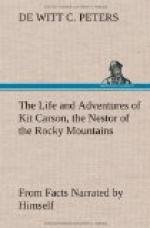much used up by overwork and privations. Thus,
when their strength was most needed, it was found
wanting. The Indians espied the soldiers in time
to make good their flight, but not quick enough to
save the lives of all their warriors. Several
of them were killed and many more were wounded.
They also lost a few of their horses, and nearly all
their camp equipage. The roughness of the section
of the country where they were overtaken, assisted
the savages in escaping, notwithstanding every effort
was made by the Americans to prevent their leaving
so easily. Kit Carson, when describing these
events, says: “To Capt. Sykes, who
commanded the infantry, is due the greatest amount
of praise for the part he acted in our adventures.
When his men were almost broken down with sore feet,
long and difficult marches, want of provisions, the
coldness of the weather, and with their clothing nearly
worn out, and when they were on the point of giving
up with despair, they were prevented from so doing
by witnessing the noble example set them by their
captain. He showed them what a soldier’s
duty really was, and this so touched their pride that
they hobbled along as if determined to follow him until
death relieved them from their sufferings. Although
this officer had a riding animal at his disposal,
yet never for once did he mount him; but instead,
he lent the horse to some deserving soldier who was
on the point of succumbing to overwork. When
the Indian village was discovered, he cheered his
men from a limping walk into a sort of run, and dashing
through a swollen mountain stream, that was nearly
up to their arm-pits and full of floating ice, he
was, with his company, the foremost in the attack.”
Two soldiers of Captain Sykes’s company[25]
were wounded, and one of them afterwards died.
The other man was severely injured, but eventually
recovered. The Indians, on being routed, were
pursued through a deep canon for about four miles.
A few who had been previously wounded were overtaken
and slain. Night now came on; therefore, the
men had to give up the chase, and on returning to their
own encampment they found their friends had located
it on the same ground which the Indians had occupied
when they were first discovered. The next morning
the surviving wounded man, with an escort, was sent
back to the nearest military post, so that he could
receive proper attention. The pursuit at an early
hour was then resumed, by the soldiers’ taking
the fresh trail of the Indians. Away went both
parties through valleys, canons, and over snow clad
mountains, until, in the end, the Americans saw that
it was impossible to overtake the red men, who began
to break up into squads of two and three and scatter
in every direction. During the latter days of
the chase, the routes which the Indians traveled were
the worst they could select; their object being, entirely
to use up the animals of their pursuers, who were
thus vigorously driving them from one haunt to another.




